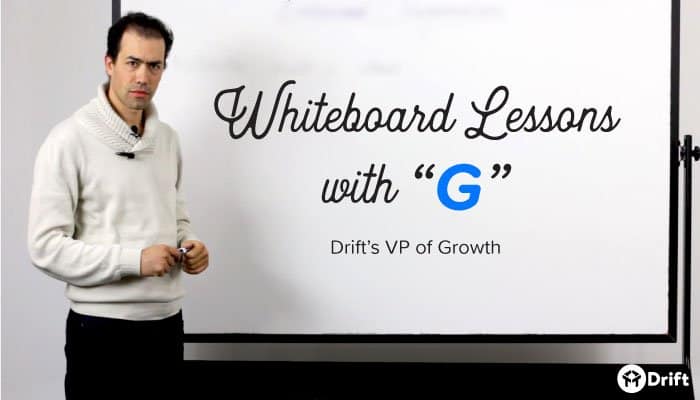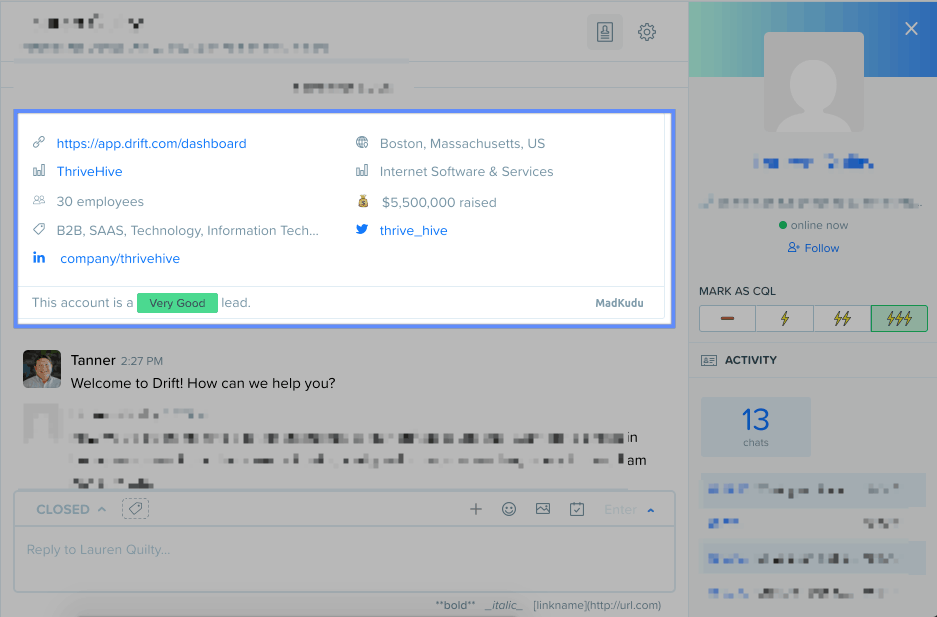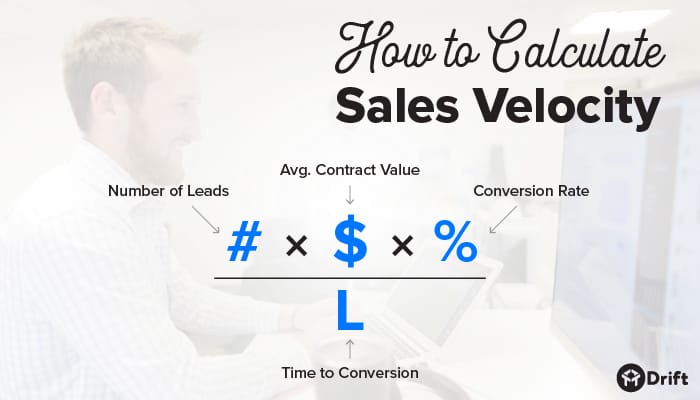
A few weeks back, we gave Drift’s VP of Growth, Guillaume Cabane (a.k.a. “G”), a marker and a whiteboard and asked him to drop some knowledge on us.
Specifically, we wanted to know: What should growth marketers be focused on in 2018? And what secrets can you share for giving teams an edge?
Ultimately, G’s advice was focused around this concept of “inbound automation,” which is something he’s been working at for the past five years now. It’s all about taking those visitors who are already coming to your website and expressing intent to buy, and figuring out how to get more of them to convert into customers.
Spoiler alert: It doesn’t involve using lead capture forms.
Instead, through using a combination of IP address matching, lead scoring, real-time messaging, and email, G has uncovered the science behind inbound automation. (He is a mad scientist, after all, a title he earned back when he was the VP of Growth at Segment.)
Here’s a breakdown of the four whiteboard lessons from G you need to watch to get ready for 2018:
- How to Engage Your High-Value Website Visitors
- How to Take a Holistic View of Inbound Automation
- How to Use Email Retargeting to Win Back Visitors Who Don’t Engage
- How to Deliver a Better Experience to Your Visitors (And Increase Conversions in the Process)
Let’s dive in.
And FYI: I’ve included summaries of each of G’s lessons below each of the videos.
[email_form paragraph=”We write regularly about growth marketing on the Drift Blog. Subscribe and we’ll send you our best growth content every week.” bold_paragraph=”Interested in Growth Marketing?” confirmation=”Awesome, welcome to the Drift community! We’ll email you.”]
1) How to Engage Your High-Value Website Visitors
When people come to your website, they’re expressing intent. But here’s the problem:
When you look at those visitors, you’ve got a ton of different profiles. Some of them are valuable. But others … not so much.
So, once you’ve established intent, how do you figure out who to target? And after that, how do you engage with them to optimize for conversions?
As G explained in the video above, the secret is using a data enrichment vendor like Clearbit, which looks at a visitor’s IP address and then matches it to a company’s domain name (e.g. company.com). Once you’ve gotten the domain, Clearbit will reveal a ton of information about the company that visitor works at, including employee count, how much funding they have, and what technologies they use.
All of that information is super helpful, because it allows you to figure out if the company is a good fit. Once you do that, you can retroactively build a lead scoring model that’s based on your past conversions.
We use a third-party vendor called MadKudu, which, like Clearbit, integrates with Drift. MadKudu gives us a score for a particular company based on past conversions, and that score ranges from “Very Good” down to “Poor.”
FYI: Here’s what that Clearbit data and MadKudu score look like when you’re having a conversation inside of Drift:

Once you know that an anonymous visitor has intent, and has a high score, you can then focus your time (and money) on maximizing your chances of converting them.
G’s secret for optimizing conversions: Create a personalized message that’s relevant to who that visitor is and what they’re doing right now. And you can have that message appear to just those visitors who have high lead scores.
To quote G:
That’s how you automate the engagement of high-value visitors with a personalized message based on nothing else but the fact that they’re coming to your site and their IP address.
2) How to Take a Holistic View of Inbound Automation
In G’s second whiteboard video, we take a step back and take a more holistic view of inbound automation.
Specifically, G explains how he built the automation logic at Drift in order for us to maximize the performance of our different campaigns for different channels.
Again, we start with when a visitor comes to our website. Then the first question we need to ask ourselves is: Can we find an IP address match?
Because the reality is that Clearbit finds a match between 30% and 50% of the time, and so that means in about half the cases you will not find a match. (So you won’t know where they work.)
In those cases, G recommends using a bot in order to ask for an email address or domain name so you know who they work for.
If you find a match using a bot, you can ask yourself: Is this company qualified? And as G showed you in his first video, you can use MadKudu to automatically score a company. And if the score is high enough, they automatically get sent back into your original flow and you can display a personalized message.
But here’s the thing:
What happens if those high-value visitors don’t want to engage with your message? Because at the end of the day, some people — even though they’re a good fit — just don’t want to chat. Do you just let those people go?
Check out G’s next whiteboard video to see what to do in those situations.
3) How to Use Email Retargeting to Win Back Visitors Who Don’t Engage
What should you do when people have the right attributes and the right qualities, but don’t engage?
To quote G: “Save them!”
And you can do that by sending an email.
The beginning of the logic is the same: You capture the IP address, get the domain, get the company details, and then you score them automatically. But now, if you have a high-quality visitor leave your site without talking to you first, you need to run an email campaign.
In order to do that, you need to find contacts. Because you can’t email an entire company, you need to email actual people. And G’s secret weapon for finding those people is a tool from Clearbit called Prospector.
This tool allows you to go from a company to a specific contact — provided you give some set of criteria (e.g. specific roles, titles, seniority levels). So you can add some filters, set a max number of contacts you want to return, and then bingo: you have people to email.
One caveat though: As G explained, this whole strategy works great for mid-market, i.e. companies with between 50 and 2,000 people. Above 2,000 people, the logic breaks down. For example, imagine you wanted to talk to engineers at Delta Air Lines. You’d have an issue, because the Delta engineering team is like 10,000 people (and you’re not going to email 10,000 people).
Once you have your list of contacts, you need to do some exclusion logic to make sure you’re not emailing people you shouldn’t be. That’s the most important part, according to G: being respectful with your emails. And that means excluding people like your existing customers, as well as people who are already talking to sales reps.
Just imagine how awful it’d be if you emailed someone who was already going through your sales process at that very moment. It’s happened to G before, and his salespeople ripped him apart.
Other people to avoid: People who have unsubscribed from getting emails from you, as well as people in Canada (because you’re not allowed to do cold email in Canada).
The next step after you set your exclusion logic: setting your drip logic. And that entails setting the max number of contacts you email in parallel within a company.
For example, say you’ve found 30 contacts at a particular company. You should never email all 30 of them at once. Instead, you can set a motion where you email three people at a time. And if no one responds, you can move onto the next three, and so on.
So that’s a cold email campaign that G has been experimenting with. And so far, he’s seen about an 80% open rate, and about a 15% response rate.
☝ Those are high numbers for email in general, and for cold email they’re especially high.
But the secret to getting those kinds of results isn’t about the subject of the email: it’s about the fit. Because, as G explained, if someone from a company comes to your website, that means they have some intent. And if they have a high lead score, i.e. if they’re the type of company you sell to, obviously you’re going to get higher open rates and response rates than normal.
If you want to get even more advanced, G recommends counting the number of unique visitors from a particular company to improve how you’re evaluating intent. For example, if there are three, four, or five visitors that come to your site all from the same company, that tells you something about intent and can inform your efforts.
In G’s final whiteboard video, he’ll explain how you can adjust your strategy (and optimize for conversions) based on that intent.
4) How to Deliver a Better Experience to Your Visitors (And Increase Conversions in the Process)
People often ask G: How do you come up with those ideas? And how do you know that they’re going to work?
The short answer: he doesn’t know for sure…but he does have some guiding principles. And his core principle, as G explained, is the following:
I want to give a better experience to my visitors, and that better experience will help them covert. People convert more when that experience is better.
Of course, that raises another question: How do you know if you’re giving a visitor a better experience? Ultimately, the answer is going to vary based on the average contract value (ACV) associated with each company. To quote G:
What I usually see is that you have some people that are very low ACV, and much fewer leads with a high ACV, so you’ve got a wide distribution of lead quality. And that calls for a mixed answer and having a differentiated approach for each of those gradients.
A key metric that G looks at is sales velocity. For people who have a very low sales velocity, a touchless experience (e.g. bots only) makes sense. For people with a medium sales velocity, a light touch experience (e.g. bots and humans) makes sense. And for people with high velocity, a high touch experience makes sense (e.g. human-to-human only, plus sending gifts).

As G explained, one of the problems we’ve been facing in marketing over the past few years is having the cost of acquisition being higher than sales velocity. Because that means you’re losing money. It means that the deal is negative, because you’re spending more than you’re making.
To quote G:
So what we’ve all done, especially growth marketers, is to use automation as a way to minimize the cost and bring the costs down. And the problem is by doing that, we’ve created awful experiences. Because the easiest way to minimize the costs is to remove the humans entirely and send the same message to everyone. Whatever the expectation, whatever their willingness to pay is, whatever their budget is. That’s awful!
The solution: Create a better experience to increase the conversion and to raise the sales velocity above the cost.
For example, if you have a high level of leads with low ACV, you can use a bot. That’s one way to lower the cost.
Or, let’s say you’ve just launched a startup, it’s been only a few months, and you’re trying to charge more to find the right price. You don’t have many leads, but the distribution of price is very high. In that case, you’ve got to open up. You’ve got to talk to everyone.
Or, if you’re like us, and you have a distribution that’s more “banana-shaped,” that’s when you can use the dynamic messaging strategy G outlined in his first whiteboard video. Ultimately, you’re trying to create the best experience based on a lead’s ACV.
So, if we go back to core principles, the important thing is being able to predict the future, predict who the customer is, what they want, and how much they’re willing to pay. And in order to do that, once again we need to start with intent.
Yes, coming to your website is one form of intent, but there are other examples, like when a company hires an executive, or they install a specific technology, or they read about specific topics, or they increase their ad spend. According to G, all of those are signs of intent that should trigger your sales teams or your automation to indicate that this company is in the market right now for your solution.
Then we have fit, which G explained earlier when he was talking about using MadKudu’s lead-scoring technology. It’s similar to identifying your target market, but it’s better than your usual rules at predicting who you’re going to sell to successfully.
Then we have channel, and G recommends using multiple channels: Email, web, messaging, ads, and sending gifts.
And finally, there’s using personalization to make sure what you’re saying is relevant. As G explained, it’s about creating the best experience possible. If the message is super relevant, people are going to like it, and they’re not going to care if the message is written automatically by a machine or a human.
To quote G:
What’s really important is whether the content of that message is valuable. Is it helpful to your prospects and customers? If it is, then good: You’re going to succeed.
But that’s only the first part. The second part is figuring out how to predict intent, which we’ll turn our attention to now.
So G’s friend at Dropbox has this framework, which is called the belief + motivation framework. Here’s a quick summary:
The people coming to your website start with a base belief. For example, they believe that messaging is good on a website, or they believe that they should do A/B testing, or they believe that they should email their customers. And so they have that base belief, and that’s pretty stable — for example, they’re not going to change their expectations around email all that quickly.
But at some point, visitors have that intent or motivation that increases enough that they land on your website and they experience your marketing. And if the marketing is good that motivation is going to go up, and in some cases, they convert immediately. But that’s rare. As G explained, most people don’t have enough belief + motivation to convert immediately, which is why the average website conversion rate is around 5%.
So what you need is a win back strategy, like the email retargeting strategy G explained in his third whiteboard video. That’s one way to do win back.
The problem: If win back is not done automatically at scale, and you leave a sales rep to do it, it’s going to be too late. Because that motivation goes down really fast. For example, If someone’s on your website now, but you wait two days to contact them, the desire could be gone by then. Or maybe the desire’s still there, but in the interim they’ve gone to a competitor who’s done a better job.
As G explained, the key is predicting and then pushing the right amount in the right direction. If you remember vectors from math class, it’s about angle and momentum.
So you’re pushing with your marketing, but usually you don’t know what people are coming for, you don’t know what brought them, so you end up pushing them in different directions. And that can create confusion.
For example, if you send an email that talks about another feature, or they wanted self service but you push them into the enterprise package — that’s confusing. Customers are coming for X, but you’re solving for Y and Z. We should be using data from advertising and from the pages they’re visiting to customize welcome messages, or to customize the emails we send. As G explained, almost no one does that, and that creates confusion and results in an awful experience.
One final point that G touched on: As head of growth, G’s job is to create yield, to create margin, and that means pushing people to convert. However, sometimes you can push too much. For example, if G said “Sign up for Drift and you’ll get a free Ferrari,” he’d be pushing with such momentum that people would definitely convert. However, he’d also be losing money.
The trick is predicting where they are on that upwards or downwards path so you can push them just the right amount to get them to convert.
So, based on the sales velocity, G knows that for one lead he might need to invest in sending a gift, like a bottle of wine. Whereas with another lead, he might only need to invest automated messaging, or sending a handwritten letter.
As G explained: “I’m just trying to nudge them over the waterfall to convert.”
Final Thought: What Else Do You Want to Learn From G in 2018?
One of our New Year’s resolutions on the Drift marketing team is to get G up to the whiteboard more often.
Because in addition to being a mad scientist, he is clearly a whiteboard wizard as well. And we want to share more of his growth secrets with you throughout the year.
So leave us a comment below and let us know:
What do you want to learn from G in 2018?



